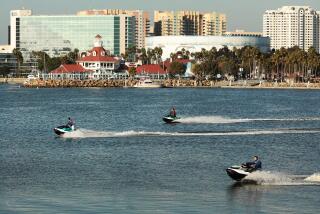Ports of L.A. and Long Beach are surging back
The resurgent tide of international trade lifted nearly all major U.S. seaports this year, but none is gaining freight and jobs like Los Angeles and Long Beach, the nation’s busiest cargo complex.
Challengers competed harder than ever this year for cargo traffic that still trails the 2006-08 boom preceding the great global recession. They were aided in their efforts by retailers that spread their goods through more ports for greater flexibility. But sometimes size really does matter, as well as the local ports’ relative proximity to Asia, trade experts said.
“Los Angeles and Long Beach have gotten their mojo back. They’ve just had their biggest single-year increase in cargo in 25 years,” said John Husing, an economist and expert on international trade’s effect on Southern California. “At first, customers were desperate to replenish inventories and get products back on store shelves, but then it didn’t stop.”
Other ports also did well this year, bouncing back from a dismal 2009. New York/New Jersey, ranked third in volume after L.A. and Long Beach, added 12.8% more cargo. Oakland, in fifth place, improved 15.3%.
But none gained as much traffic as Los Angeles and Long Beach, which together handled 20.3% more cargo boxes than in 2009. Cargo traffic through the twin ports grew by 2.4 million containers, for a total of about 14.2 million for 2010, including estimated December cargo movement. Line up the year’s tally of 20-foot containers and there would be more than enough to circle the globe twice. Stack them and they would reach higher than a geosynchronous satellite.
Before the global recession, importers with long memories became concerned about their overwhelming reliance on Los Angeles and Long Beach in particular and on the West Coast in general as the dominant gateways for Asian trade.
Between 2002 and 2008, shippers had to contend with a parade of problems. There was a lockout of West Coast dockworkers; ships were delayed because of too few dockworkers and too few rail resources to haul the unanticipated flood of trade; El Niño deluges wiped out miles of railroad track.
National retailers were so troubled that they began regular monitoring of congestion at the nation’s top ports.
“The haulers, freight forwarders and supply-chain experts who move that cargo were advising customers to adopt a ‘four corners’ strategy: Reduce your reliance on Southern California and the West Coast. Send some through Canada, to the East Coast and to the Gulf Coast, for flexibility,” said Husing, who runs the Redlands firm Economics and Politics Inc.
That all changed as worldwide economies began slowing down, when U.S. importers, manufacturers, retailers and others cut their inventories of components and finished goods to record low levels, according to the Council of Supply Chain Management Officials.
By 2010, with importers desperate to refill their warehouses, factories and store shelves, the stakes had changed, according to Asaf Ashar, a professor with the University of New Orleans’ National Ports and Waterways Institute. Why rely on ports that move a million cargo containers in six months to a year when Los Angeles and Long Beach can move that much in three weeks?
“If you have to replenish your inventory as fast as possible, you will probably go to Los Angeles and Long Beach,” Ashar said. “Big ports are always more sensitive to changes in the economy. So coming out of the recession, Los Angeles and Long Beach were the first to benefit.”
The ability to move more cargo than anywhere else in the country is an integral part of the marketing strategy of both ports. Long Beach’s campaign, for example, features a map of the Pacific Ocean depicting a line for each of the weekly vessel calls to West Coast ports: two to Prince Rupert, Canada; 16 to Vancouver, Canada; eight each to Seattle and Tacoma, Wash.; and 40 to San Pedro/Long Beach.
“If you are looking for frequency and reliability, Southern California offers the major opportunities,” said Richard D. Steinke, executive director of the Port of Long Beach. “Customers know they have more options here.”
Geraldine Knatz, executive director of the Port of Los Angeles, said she has a team crisscrossing the U.S. every month, touting the advantages of moving goods through the port.
“We have really ramped up our marketing-intensive visits to all of the cargo owners,” Knatz said. “It’s hard to say that this is what has caused the increases, but we are working hard to sell the advantages that we have.”
The payoff has included brand-new cargo services for both ports. Long Beach added Pan Ocean Shipping Co. and TS Lines while Los Angeles added the Container Ship Co. — all of which added new sailings from China.
Los Angeles and Long Beach should flourish as long as China remains integral to the U.S. economy, said Jock O’Connell, international trade advisor to Beacon Economics of San Rafael, Calif.
“Theirs is a story of China in many respects,” O’Connell said of the two ports. “As long as China remains the principal source of U.S. imports, then the Los Angeles and Long Beach ports should thrive.”
Adrian Fleissig, a professor at the Cal State Fullerton Institute of Environmental and Economic Studies, said that another factor was the growing significance of locally based exports. Fleissig recently co-wrote a report predicting that by 2012, local exports would surpass the record levels set during the global economic boom.
“The share of Los Angeles, Long Beach and Santa Ana exports has risen steadily over the past decade, and now it is rising again after the end of the recession,” Fleissig said. “That reflects the strength of those emerging Asian economies and the demand for products that are produced here.”
More to Read
Inside the business of entertainment
The Wide Shot brings you news, analysis and insights on everything from streaming wars to production — and what it all means for the future.
You may occasionally receive promotional content from the Los Angeles Times.











